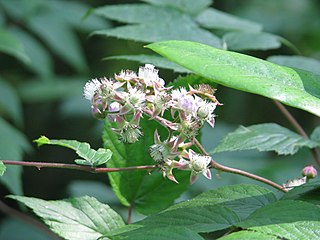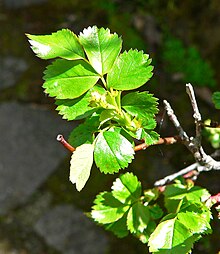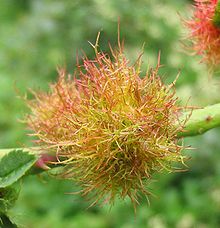
Mahonia aquifolium, the Oregon grape or holly-leaved barberry, is a species of flowering plant in the family Berberidaceae, native to western North America. It is an evergreen shrub growing 1–3 meters tall and 1.5 m (5 ft) wide, with pinnate leaves consisting of spiny leaflets, and dense clusters of yellow flowers in early spring, followed by dark bluish-black berries.

Rosa rugosa is a species of rose native to eastern Asia, in northeastern China, Japan, Korea and southeastern Siberia, where it grows on beach coasts, often on sand dunes. It should not be confused with Rosa multiflora, which is also known as "Japanese rose". The Latin word "rugosa" means "wrinkled", referring to the wrinkled leaves. Often used as an ornamental plant, it has become invasive in parts of Europe, North America and South America.

Rubus spectabilis, the salmonberry, is a species of bramble in the rose family Rosaceae, native to the west coast of North America from west-central Alaska to California, inland as far as Idaho. Like many other species in the genus Rubus, the salmonberry plant bears edible fruit, typically yellow-orange or red in color, resembling raspberries in appearance.

Spiraea douglasii is a species of flowering plant in the rose family native to western North America. Common names include hardhack,hardhack steeplebush, Douglas' spirea, douglasspirea, steeplebush, and rose spirea.

Rosa nutkana, the Nootka rose, bristly rose, or wild rose is a 0.6–3.0-metre-tall (2–10-foot) perennial shrub in the rose family (Rosaceae).

Rubus cockburnianus, the white-stemmed bramble, is a species of flowering plant in the family Rosaceae. It is endemic to China. It was named by the botanist William Hemsley to honour the Cockburn family.

Polemonium carneum is a plant native to the northwestern United States west of the crest of the Cascade Range, from Washington south through Oregon to the San Francisco Bay Area in California.

Rosa virginiana, commonly known as the Virginia rose, common wild rose or prairie rose, is a woody perennial in the rose family native to eastern North America, where it is the most common wild rose. It is deciduous, forming a suckering shrub up to 2 metres in height, though often less. The stems are covered in numerous hooked prickles. The leaves are pinnate, usually with between 7 and 9 glossy leaflets. The pink flowers are borne singly or in small clusters and appear over a long period in midsummer. The fruits are small, round and bright red, rich in vitamin C and edible, being both used to make jams and tea. It grows in clearings, thickets, and shores. The plant attracts birds, bees, butterflies, and hummingbirds.

Rosa carolina, commonly known as the Carolina rose, pasture rose, or prairie rose, is a perennial shrub in the rose family native to eastern North America. It can be found in nearly all US states and Canadian provinces east of the Great Plains. It is common throughout its range and can be found in a wide variety of open habitats, from thickets and open woods to roadsides and along railroads.

Rubus armeniacus, the Himalayan blackberry or Armenian blackberry, is a species of Rubus in the blackberry group Rubus subgenus Rubus series Discolores Focke. It is native to Armenia and Northern Iran, and widely naturalised elsewhere. Both its scientific name and origin have been the subject of much confusion, with much of the literature referring to it as either Rubus procerus or Rubus discolor, and often mistakenly citing its origin as western European. Flora of North America, published in 2014, considers the taxonomy unsettled, and tentatively uses the older name Rubus bifrons.

Rosa californica, the California wildrose, or California rose, is a species of rose native to the U.S. states of California and Oregon and the northern part of Baja California, Mexico. The plant is native to chaparral and woodlands and the Sierra Nevada foothills, and can survive drought, though it grows most abundantly in moist soils near water sources.

Rosa gymnocarpa is a species of rose native to western North America. It is known by the common names dwarf rose, baldhip rose, and wood rose. It grows in shady, damp, and rich forests.

Sambucus racemosa is a species of elderberry known by the common names red elderberry and red-berried elder.

Astragalus purshii is a species of milkvetch known by the common names woollypod milkvetch and Pursh's milkvetch.

Rosa bridgesii is a species of rose known by the common names pygmy rose and Sierran dwarf rose. It is native to California, where it grows in the forests of the Sierra Nevada and surrounding mountains and foothills. It may also occur in Oregon.

Rosa spithamea is a species of rose known by the common names ground rose and coast ground rose. It is native to Oregon and California, where it grows in forest and chaparral habitats, especially areas recently burned.

Rosa woodsii is a species of wild rose known by the common names Woods' rose, interior rose, common wild rose, mountain rose, pear-hip rose, and prairie rose.

Rosa nitida, also known as the shining rose due to its glossy leaves, is a perennial species in the plant genus Rosa in the plant family Rosaceae. It is native to northeastern North America, from Connecticut north to Newfoundland and Quebec. It forms a low, suckering, deciduous shrub, growing up to a metre in height, although often less. Its stems are thin and covered in fine bristles. Its pinnate leaves have 7 to 9 shining leaflets which turn bright red, yellow and purple in the fall. Its small pink flowers appear in summer and are subtly but sweetly scented, smelling like Convallaria ("Lily-of-the-Valley"). They are followed by small, round, red hips.

Potentilla villosa is a species of flowering plant in the rose family, Rosaceae. Its common names include villous cinquefoil, northern cinquefoil, and hairy cinquefoil. It is native to northwestern North America, where its distribution extends from Alaska to Alberta to Oregon. There are records from eastern Asia.

Rosa setigera, commonly known as the climbing rose, the prairie rose, or the climbing wild rose, is a shrub or vine in the Rosaceae (rose) family native to central and eastern North America.






















